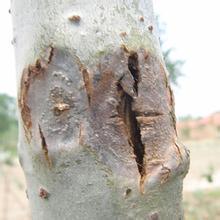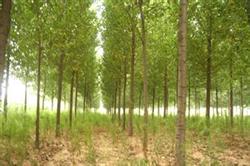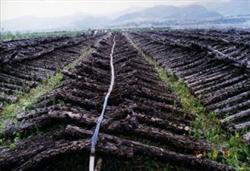Control of common insect pests in poplar

Poplar pests mainly include leaf-eating pests, stinging and sucking pests and boring pests. The main pest control methods of poplar in our area are as follows: 1. Leaf-eating pests. Mainly to Yang Fan boat moth, Yang boat moth, yellow thorn moth (commonly known as foreign chilli) and so on. Poplar from seedling stage to mature stage are damaged by the above pests, resulting in leaf defects or eat up. Young trees (1~4 years old) are damaged, which has a great impact on growth and survival. Prevention methods: 1, artificial control. Combined with tree pruning, pruning, weeding and other tending management measures, artificial killing pupae and nests. Adults are phototactic (May to October) and can be trapped by light. 2. Chemical control. Larvae harm stage (June to September), the general selection of dimethoate or 80% dichlorvos 1000 times spray control, but also trunk injection "Baolin No. 3" for control. II. Stinging and sucking pests. Mostly grass bugs. In the early spring, the grass scale on the tree sucks the tender shoots and tender shoots of trees, causing the whole plant to die. Therefore, the control of Drosophila incognita should be carried out in front of trees on early spring nymph. Prevention methods: 1, artificial control. The bottom of the trunk is tied with plastic cloth or wrapped with plastic tape to block the upper tree. Before the nymph goes up the tree (in the middle of February), tie a plastic sheet (new plastic sheet is better) about 20cm wide to the bottom of the trunk with two strings or wrap adhesive tape at the bottom of the trunk. The blocking rate can reach more than 98%. The effect is more obvious when artificial culling is assisted. 2. Chemical control. The trunk below 1 meter is coated with waste oil and organophosphorus pesticide ring with 10 cm wide medicine ring to prevent grass scale from climbing trees or touching medicine to kill it. If on the tree, available 50% dichlorvos or dimethoate and other pesticides 1000 times spray control. 3. Borer pests. There are mainly mulberry longicorn, Anoplophora glabripennis, cloud spot longicorn, etc. In larval stage, obvious drainage holes can be seen on the trunk, and sawdust is exposed. Control methods: 1, silviculture measures. This is a preventive measure to avoid forest disasters by adjusting the forest structure. Such as poplar can not be mixed with mulberry, otherwise poplar easy to occur mulberry longicorn. 2. Quarantine measures. Quarantine is an effective means to prevent the spread of longicorn beetle. All seedlings, wood and packaging boxes from epidemic areas must be quarantined before they can be transported. 3. Artificial control. Cut down trees with serious pests, cut off large branches caused by pests, and timely carry out pest control. At the peak of adult oviposition, check the grooves on the trunk (mostly in the branches and branches), and kill the eggs or larvae above the grooves with a small hammer. During the adult stage, the trunk is shaken to shake off the adults and kill them. 4. Chemical control. Find the freshest drain hole, inject the mixture of dichlorvos stock solution and diesel oil into the bore hole, and plug the bore hole with wet mud. Zinc poison sticks can also be inserted into the first hole at the base of the trunk and a hole in the upper part, and other holes can be blocked with wet mud.
- Prev

Poplar pest control
Poplar pests can be divided into the following categories in terms of damage methods and control measures: first, leaf-eating pests: mainly poplar fan boat moth, poplar small boat moth, poplar two-tail boat moth, poplar leaf borer, diamondback moth, beetle and so on. Poplar is damaged by the above pests from seedling stage to mature stage, causing leaf defect or eating up.
- Next

Inoculation technique of Auricularia auricula
1. The fog irrigation facility is composed of dry, branch and wool high pressure polyethylene plastic pipe micro atomization nozzles and pipe fittings. The diameter of the main pipe is 40ml 50mm, the diameter of the branch pipe is 25mm 12mm, and the diameter of the capillary tube is 10mm 12mm. During installation, the water source of the main pipe is perpendicular to the branch pipe, the branch pipe is perpendicular to each ear trunk, and the capillary (usually 15.
Related
- Fuxing push coffee new agricultural production and marketing class: lack of small-scale processing plants
- Jujube rice field leisure farm deep ploughing Yilan for five years to create a space for organic food and play
- Nongyu Farm-A trial of organic papaya for brave women with advanced technology
- Four points for attention in the prevention and control of diseases and insect pests of edible fungi
- How to add nutrient solution to Edible Fungi
- Is there any good way to control edible fungus mites?
- Open Inoculation Technology of Edible Fungi
- Is there any clever way to use fertilizer for edible fungus in winter?
- What agents are used to kill the pathogens of edible fungi in the mushroom shed?
- Rapid drying of Edible Fungi

